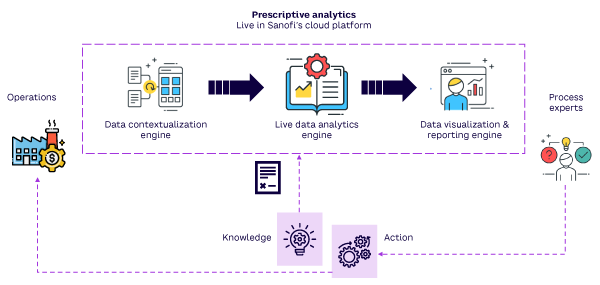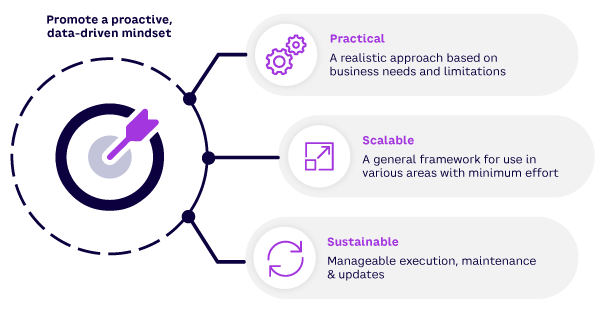AMPLIFY VOL. 37, NO. 6

Proactivity isn’t a choice in biopharmaceutical manufacturing; it’s a fundamental need. The high costs associated with suboptimal process performance, which can result in significant delays or even a manufacturing halt, mean that continuing with outdated methods is no longer feasible. As a process data science team, our goal is to provide process scientists and production managers with the tools they need to proactively identify and address potential issues in vaccine production. By integrating prescriptive analytics into our workflows, we enable our scientists to take data-driven actions and effectively resolve challenges.
From a broader perspective, it’s important to recognize that digital transformation goes beyond adopting new technologies; it’s about fundamentally changing how organizations operate, think, and innovate. This shift requires moving away from traditional mindsets, questioning established norms, and seeing uncertainty as an opportunity for innovation. This is particularly important in process data analytics, where extracting useful insights from complex data relies on collaboration between data, process, operational, and quality teams. We need insights that align with scientific relevance and fit within operational constraints and quality expectations. This is essential since several parameters come into play, and correlations may occur by chance, rather than indicating causation.
Businesses understandably aim for predictability and control in the digital age, but the dynamic nature of manufacturing operations often challenges these rigid expectations. Thus, process variability, rather than being an anomaly, should be considered an inherent characteristic of the manufacturing landscape, providing a rich yet challenging environment for adaptation and progress. Recognizing the complexity of these operations, we have embraced the notion that process variability is not an obstacle but a resource to be harnessed for innovation, optimizing process performance and gaining insight.
This understanding has been the driving force behind our proactive approach to monitoring and troubleshooting manufacturing processes through the deployment of prescriptive analytics. Building on the pillars of product safety, quality, and efficacy, we aim to leverage data analytics not just to meet regulatory demands but to foster sustainable growth.
In a previous Amplify article, we outlined the rationale behind transitioning from reactive modes of data analytics (namely descriptive and diagnostic analytics) to a proactive approach through prescriptive analytics.1 We presented the main technical components of the solution (data contextualization, live analytics engine, and visualization/reporting) and emphasized the potential benefits of this shift, which included performing analytics at speed to reduce reaction times in process troubleshooting, faster recovery of manufacturing operations, and acting on data-driven insights to ensure process robustness, yield management, and predictable supply.
This article is a reflection on our experiences, challenges, and successes during that journey, highlighting the transition from vision to action in adopting prescriptive analytics methodologies (see Figure 1).

Vision & Strategy
Our prescriptive analytics implementation was rooted in our vision to improve operational efficiency and product quality by shifting from reactive to proactive modes of operation. In short, we conceptualized a pragmatic digital capability that could be integrated with a new way of working to proactively identify and expediently resolve process-related challenges.
This vision translated into a primary objective: empowering stakeholders with rapid and live data analytics capabilities, enabling swift monitoring of the latest batches, and providing process-related suggestions to mitigate or avoid unfavorable process-performance situations. We aimed to detect anomalies and divergence in process performance while providing actionable recommendations to mitigate potential issues. To reach this objective, we formulated a strategy that prioritized practicality, scalability, and sustainability in product design and deployment (see Figure 2).

In designing the product, we took a practical, realistic approach that addressed the specific needs and limitations of our business environment. Numerous ideas were proposed, but we recognized the importance of simplicity and effectiveness in ensuring user adoption and decision-making support. We therefore focused on providing actionable information without requiring users to run models or manipulate data sets. This streamlined approach ensured that the tool remained user-friendly and streamlined decision-making.
Our strategy also placed a significant emphasis on scalability, striving to craft a general framework that could be adapted to various process areas with minimal effort. Embracing a product-agnostic approach facilitated rapid deployment, enabling seamless integration into new areas in a matter of days. By formulating a business knowledge and parameter-mapping database to collect product- and process-specific requirements for each area and generating generalized code for visualizations and insights, we laid the groundwork for a scalable solution capable of evolving alongside our expanding facilities and products.
To ensure sustainability, we paid close attention to managing the execution, maintenance, and updates of the product within existing resource constraints. Effectively balancing the workload of the new product with ongoing tasks, projects, and manufacturing support ensured its viability and efficacy. Our aim was not to add to the workload of our teams, but rather to streamline their processes and provide them with the tools necessary to make informed decisions.
Product Launch
The unveiling of our prescriptive analytics solution marked a pivotal moment in our journey toward transforming pharmaceutical manufacturing at Sanofi. Our primary goal was to capture the attention of subject matter experts (SMEs) and end users, reassuring them that the tool was designed to complement their expertise rather than replace it.
To achieve this, we focused on ensuring that users understood the practical benefits of the tool and felt empowered to interpret its results. We spent considerable time on user training and support, guiding individuals through the application’s interface and demonstrating its utility in real-world scenarios. By emphasizing the tool’s role in enhancing decision-making and streamlining processes, we fostered enthusiasm and buy-in from frontline staff, laying the foundation for successful adoption.
However, the unveiling of the product presented challenges, particularly in engaging managers who were less familiar with the nuances of our previous workflows and data limitations. To maintain a balance between political correctness and a need for pragmatism, we focused on the tool’s potential to address longstanding challenges and improve operational efficiency. By emphasizing the simplicity and user-friendliness of the interface, we sought to bridge the gap between technical complexity and managerial oversight, ensuring that all stakeholders understood the value proposition of the prescriptive analytics solution.
Successful user adoption in one area after another served as critical milestones in our journey, setting the stage for widespread acceptance and integration of advanced analytics into our manufacturing operations.
Iterative Refinement
We recognized early on the importance of ensuring a smooth, efficient user interface, particularly in contrast to existing tools with unfriendly navigation and lengthy computational times. We worked diligently to simplify the user experience, starting with familiar visualization formats and progressively integrating advanced analytics for deeper insights. This approach facilitated adoption and encouraged users to explore the tool’s capabilities.
Initially delivered as a static PDF, the transition to an interactive application proved instrumental. This shift enhanced accessibility and generated significant interest from other areas within Sanofi, which were eager to replicate the success seen with our initial implementation. By incorporating additional features that facilitate rapid decision-making, we expanded the tool’s utility, catering to diverse user needs and enhancing its overall value proposition. Through continuous iteration guided by user feedback, we ensured that the prescriptive analytics solution remained agile and responsive to evolving user requirements, ultimately driving tangible improvements in operational efficiency and product quality.
Empowering Decision Makers
A significant milestone in our implementation was the profound impact on decision-making processes within the data science team. By accelerating response times from days to minutes, our prescriptive analytics tool revolutionized the way critical insights were generated and acted on.
The dramatic reduction in response time provided decision makers with more time to perform in-depth follow-up analyses and facilitated resource reallocation. Freeing up valuable personnel to build more advanced models (e.g., mechanistic modeling programs) enhanced our analytical capabilities. The standardization of data analysis and reporting ensured consistency and reliability across the board.
The true measure of success lies in the intangible yet profound way our solution empowered process scientists and SMEs to swiftly analyze and respond to evolving situations. Achieving this cultural shift was not without challenges; it required collaboration with senior leadership to garner support and seamlessly integrate the tool into existing workflows. Amidst high-pressure scenarios, our solution provided these individuals with newfound clarity and insight into the dynamics within their areas, helping them swiftly make informed decisions.
Quantifying the impact of this transformation isn’t simple, but its significance is undeniable. With faster analytics, decision-making has accelerated, letting the team swiftly return to expected process behaviors and avoid costs associated with production schedule disruptions. The reduction in investigation time led to tangible savings, including lead-time reduction, time savings during troubleshooting, and proactive intervention to ensure process robustness.
Moreover, having relevant analytics at hand alleviates stress during high-pressure investigations. This allows individuals to focus more effectively on the process and scientific aspects, enhancing learning through troubleshooting activities. This improved focus is beneficial to employees, contributing to job satisfaction and helping workers maintain a healthy work/life balance. In essence, empowering our team amplifies the output of our most valuable asset: our people.
Looking Ahead
Looking ahead, our broad vision involves fostering a culture that values data-centric, proactive decision-making. Our current prescriptive analytics tool has played a pivotal role for three years, but its true significance lies in the cultural shift it has ignited within our organization.
Our mission is to empower people and drive meaningful change. As we evolve, our focus remains on sustaining this culture of innovation, ensuring that our commitment to data-driven insights guides our decisions.
Reference
1 Sahraei, Hossein, et al. “Sanofi’s Move Toward Prescriptive Data Analytics.” Amplify, Vol. 35, No. 3, 2022.






